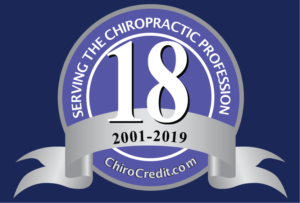Chiropractic Adjustments Reduce Fatigue and Increase Neural Drive
 Over the last decade, research has demonstrated that spinal manipulation can change various aspects of nervous system function, including muscle reflexes, cognitive processing, reaction time, and the speed at which the brain processes information. One research group from New Zealand (Haavik Taylor et al) has hypothesized that the joint dysfunction part of the chiropractic clinical construct, the vertebral subluxation, results in altered afferent input to the central nervous system (CNS) that modifies the way in which the CNS processes and integrates all subsequent sensory input. This processing (i.e., sensorimotor integration) is a central nervous system (CNS) function that appears most vulnerable to altered inputs. Many studies show that chiropractic adjustments result in changes to sensorimotor integration within the central nervous system.
Over the last decade, research has demonstrated that spinal manipulation can change various aspects of nervous system function, including muscle reflexes, cognitive processing, reaction time, and the speed at which the brain processes information. One research group from New Zealand (Haavik Taylor et al) has hypothesized that the joint dysfunction part of the chiropractic clinical construct, the vertebral subluxation, results in altered afferent input to the central nervous system (CNS) that modifies the way in which the CNS processes and integrates all subsequent sensory input. This processing (i.e., sensorimotor integration) is a central nervous system (CNS) function that appears most vulnerable to altered inputs. Many studies show that chiropractic adjustments result in changes to sensorimotor integration within the central nervous system.
A new study sought to investigate possible neural plastic changes with spinal manipulation by measuring H-reflexes and V-waves. The H-reflex is an electrically evoked response that operates via the same neuronal circuitry as stretch reflexes. The H (Hoffmann) reflex may be useful to assess motoneuron excitability in vivo while also reflecting presynaptic inhibition of Ia afferent synapses. The so-called V-wave, which is an electrophysiological variant of the H-reflex, can be recorded during maximal voluntary motor contractions. The elicited V-wave response may be used to reflect the level of efferent neural drive from spinal α-motoneurons during maximal voluntary contraction (MVC).
Results of the study:
- the threshold to elicit the H-reflex significantly decreased by 8.5% in the spinal manipulation group
- the SEMGs showed a significant drop in the power spectrum after controls but there was no fatigue demonstrated in the power spectrum after spinal manipulation
- for study 1: maximal voluntary contraction as determined by SEMG increased significantly by 59.5% after spinal manipulation and decreased significantly by 13.3% after control
- for study 2: maximal voluntary contraction increased significantly by 16.1% after spinal manipulation and decreased significantly by 11.4% after control
- the V-wave amplitude (V/Mmax ratio) increased significantly by 45% after spinal manipulation and reduced significantly by 23% after control
Key Points
- This study is the first to indicate that chiropractic adjustments can induce significant changes in the net excitability for the low-threshold motor units/and or alters the synaptic efficacy of the Ia synapse
- the improvements in maximal voluntary contraction following spinal manipulation are likely attributed to the increased descending drive and/or modulation in afferents
- spinal manipulation prevents fatigue
- these results suggest that spinal manipulation may be indicated as part of the treatment for the patients who have lost tonus of their muscle and/or are recovering from muscle dysfunction such as stroke or orthopedic operations
- These findings will also be of interest to athletes and perhaps the general public






